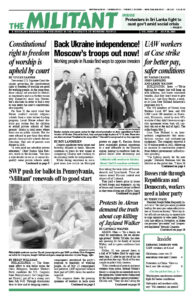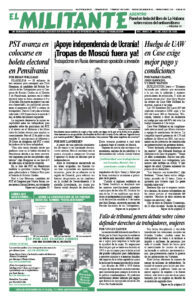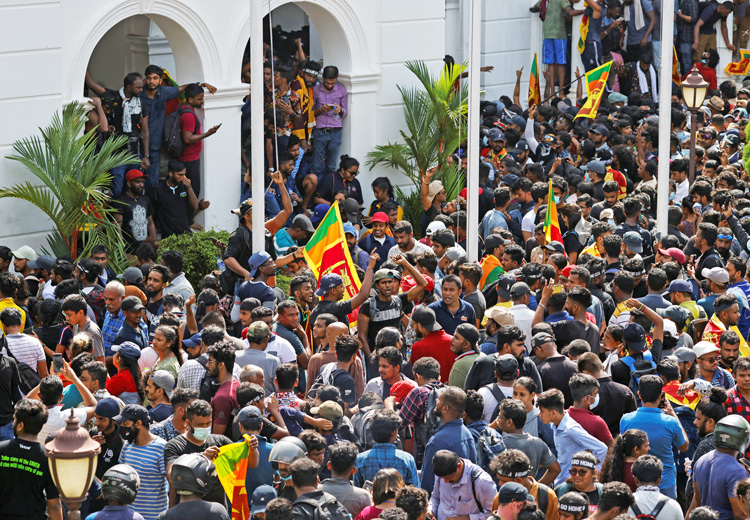Faced with months of determined and massive protests over their handling of the country’s crippling social and economic crisis, and widespread corruption, Sri Lanka President Gotabaya Rajapaksa and Prime Minister Ranil Wickremesinghe announced July 9 that they would resign soon. Rajapaksa has fled the country.
Despite the shutdown of most public transportation and many workplaces, arrests and attacks on demonstrators by the army and police, 100,000 people joined a July 9 protest in Colombo, the capital, piling onto semitrailer trucks, trains and overcrowded buses, or walking for miles.
For the first time since the start of daily protests in March, soldiers joined the actions. Thousands of protesters occupied Rajapaksa’s luxurious home in Colombo. Volunteers organized to keep order as thousands toured the home, while police and soldiers stood aside.
Many were amazed at the opulence of Rajapaksa’s residence with its private complex with swimming pool and fancy menus, while at least a quarter of Sri Lanka’s 22 million people are skipping meals.
Leaders of the Aragalaya “struggle” coalition say they won’t halt the actions until power is handed over to an interim government that excludes Rajapaksa’s Sri Lanka Podujana Party, establishes a new constitution, and calls elections.
Some 70% of Sri Lanka’s 22 million people are Buddhists; 12.6% are Hindus, mostly ethnic Tamils; 9.7% are Muslim; and 7.4% are Christian.
In 2019 Rajapaksa won the election largely on the promise of shutting down Islamist groups that had carried out bombings that killed nearly 270 people.
A striking feature of the recent protests has been unity of the main ethnic groups, despite attempts by the regime to keep working people divided.
Little fuel left
The government defaulted on its foreign debt in May, missing interest payments on some $2.5 billion in bonds, part of its $50 billion foreign debt.
In a first for any country since the 1970s, the government halted all “nonessential” fuel sales at the end of June, leaving most working people without gas and diesel. Officials said there was less than a week’s worth of fuel left for essential services.
Taxi drivers and others have waited at gas stations in mileslong lines for days. Public employees have been instructed to work from home. Schools are closed. Electricity is cut off three to four hours a day. The price of rice has increased nearly 300% in the last year, and tomatoes by 400%. Essential medicines are scarce.
IMF bailout will squeeze workers
A delegation from the International Monetary Fund left Sri Lanka in early July without an agreement on giving the government a $3 billion “bailout.” Any new loans by the IMF would go to cover interest payments on outstanding loans, not for investment or infrastructure. In exchange for buying time by sinking the country deeper in debt, the IMF is demanding a new “macroeconomic and structural policy package.” In other words, squeeze more out of working people.
Much press coverage centers on blaming the crisis on corruption and policies of the Rajapaksa family, which has played the central role in the government for decades.
After 2009 Sri Lanka became a “popular destination for bondholders looking for high-yielding investment opportunities,” notes the Financial Times. In other words, the government borrowed at high interest rates, often for vanity projects that lined the pockets of the Rajapaksa dynasty. This includes the Beijing-built, largely unused Hambantota international port and airport near the Rajapaksas ancestral village.
Making matters worse, in 2021 the government banned synthetic fertilizers and pesticides in the name of promoting “organic” farming and saving on import costs. That was an unmitigated disaster, causing a 14% to 20% drop in rice production and a shrinking tea crop, Sri Lanka’s second-biggest export. Protests by farmers forced a lifting of the ban, but by then the government didn’t have the hard currency needed to import enough for this year’s crop.
Like many semicolonial countries, Sri Lanka has been especially hard hit by the worldwide capitalist crisis and the drop in trade and tourism made worse by the COVID-19 pandemic. Soaring prices for imported oil, fertilizers and pesticides have battered the country.
Competing capitalist powers continue to maneuver to make sure their banks and bondholders get paid first. Some of the biggest holders of Sri Lankan debt are governments and lenders in China, Japan and India.
The Sri Lankan government offered up territory as collateral to Beijing. When it defaulted on loans for the construction of the Hambantota port it had to hand over the entire facility in 2017, and 15,000 acres surrounding it, to the Chinese government for 99 years. In exchange, Beijing forgave $1.2 billion in debt. This gives the Chinese rulers a foothold in a major commercial and military waterway.
The Sri Lankan government still faces debt payments to Beijing of $1.5 billion to $2 billion this year. The government has only $25 million in hard currency on hand, while fuel costs alone are $500 million a month
None of the bourgeois opposition parties have any road forward out of this crisis that can advance the interests of working people. And a revolutionary-minded working-class leadership has yet to emerge from the struggle.


